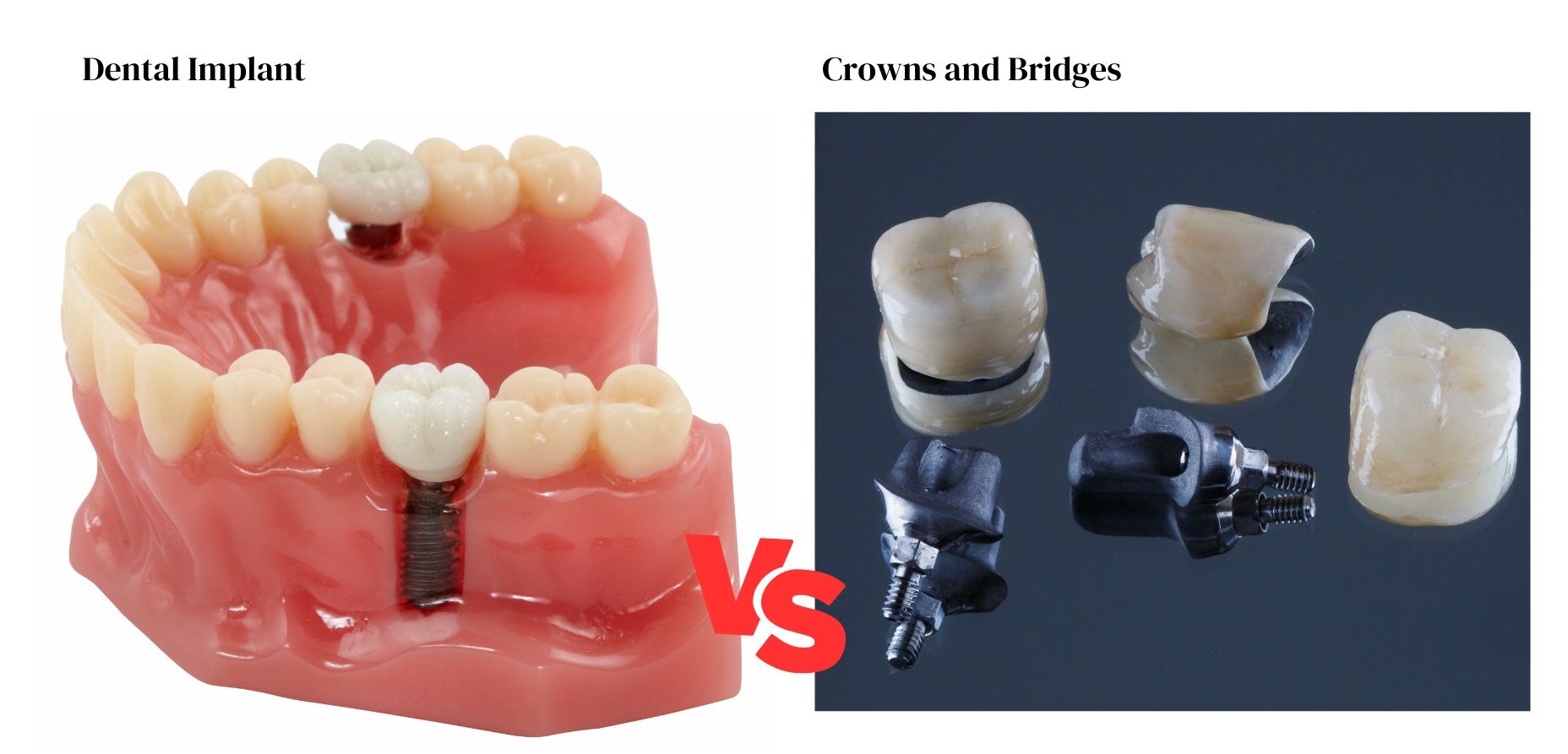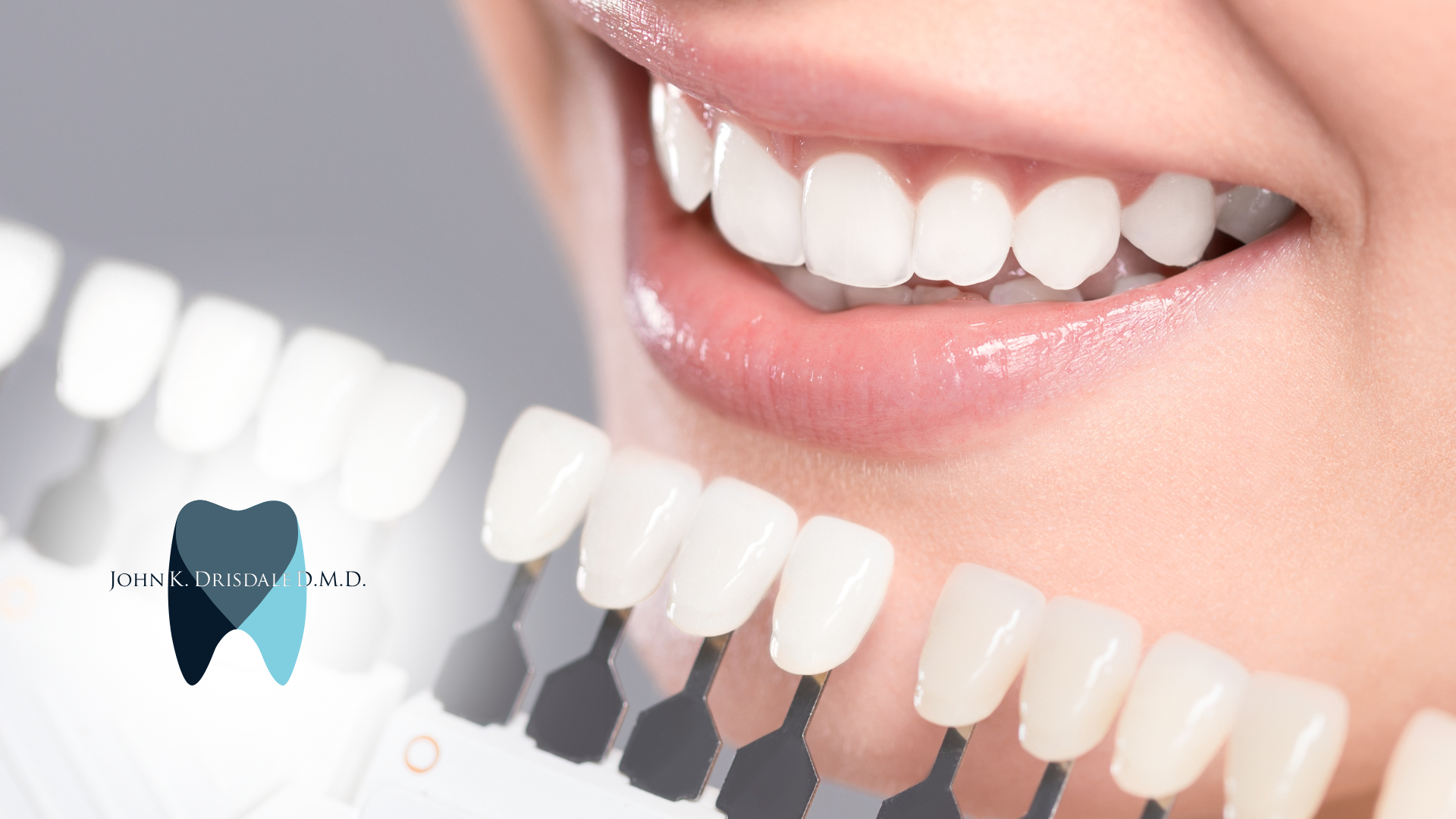Dental Implants vs Crowns and Bridges: Which is the Best Long-Term Solution
Understanding Dental Implants, Crowns, and Bridges
Defining Dental Implants
Dental implants are a modern solution for replacing missing teeth, designed to mimic the structure and function of natural teeth. They consist of three main components:
- The implant: A titanium post that is surgically placed into the jawbone.
- The abutment: A connector that attaches to the top of the implant.
- The crown: A custom-made prosthetic tooth that is mounted on the abutment.
Dental implants integrate with the bone through a process called osseointegration, providing a stable and durable foundation for the artificial tooth. Unlike other dental restorations, dental implants do not require support from adjacent teeth, which helps to preserve the overall health of your mouth.
Dental implants offer a long-term solution for tooth loss, with the potential to last a lifetime with proper care and maintenance.
What Are Crowns?
Dental crowns are a form of restorative treatment used to repair and protect a damaged tooth. They are custom-made to fit over the entire tooth, starting at the gum line, effectively encasing the tooth in a protective material. Crowns can be made from various materials, including porcelain, ceramic, metal, or a combination of these materials.
- Porcelain and ceramic crowns are popular for their natural appearance, making them an excellent choice for front teeth restorations.
- Metal crowns, often made of gold or alloys, are more durable and are typically used for molars that endure the brunt of chewing.
Crowns serve not only to restore the shape and function of a tooth but also to enhance its aesthetic appearance. They are a common solution for teeth that have been weakened by decay, fracture, or a large filling.
When properly maintained, dental crowns can last for many years, providing a long-term solution for maintaining a healthy and attractive smile.
The Role of Bridges in Dental Restoration
Dental bridges serve as a solution for filling the gap created by one or more missing teeth. A bridge is typically comprised of two or more crowns for the teeth on either side of the gap, with a false tooth or teeth in between. These anchoring teeth are known as abutment teeth, and the false teeth are referred to as pontics.
Bridges can be supported by natural teeth or by implants, which determines the procedure's complexity and stability. The materials used for bridges include porcelain, gold, alloys, or a combination of these materials, chosen for their aesthetic and functional properties.
- Porcelain bridges often match the color of natural teeth and are preferred for their aesthetic appeal.
- Metal alloys are known for their strength and durability.
- Gold bridges, while less common, offer a unique appearance and remarkable longevity.
Bridges not only restore the appearance of a smile but also maintain the shape of the face, distribute the forces in your bite properly, and prevent remaining teeth from drifting out of position.
Comparative Analysis of Durability and Longevity
The Lifespan of Dental Implants
Dental implants are renowned for their durability and often considered a permanent solution for tooth loss. With proper care, they can last a lifetime, typically exceeding 25 years. The success rate of dental implants is high, with studies showing over 90% effectiveness over a 10-year period.
- Implant material: Made of titanium, implants fuse with the jawbone in a process called osseointegration.
- Oral hygiene: Regular brushing, flossing, and dental check-ups are crucial for longevity.
- Lifestyle factors: Smoking and certain medical conditions can affect implant lifespan.
The key to maximizing the lifespan of dental implants lies in maintaining excellent oral hygiene and regular dental visits. While they may require periodic adjustments, they are less likely to need replacement compared to crowns and bridges.
How Long Do Crowns and Bridges Last?
The longevity of crowns and bridges can vary significantly based on the materials used, the quality of the dental work, and the patient's oral hygiene habits. On average, dental crowns can last between 5 to 15 years, while bridges may serve well for 5 to 7 years before requiring maintenance or replacement.
- Porcelain fused to metal (PFM) crowns typically offer a balance between strength and aesthetics.
- All-ceramic crowns are preferred for their natural appearance but may not be as durable as PFM crowns.
- Metal crowns, made of gold or other alloys, are the most durable but less commonly used due to their appearance.
It's essential to maintain regular dental check-ups and practice good oral hygiene to extend the life of crowns and bridges.
Factors such as dental hygiene, the force of bite, and habits like grinding or clenching can impact the longevity of these restorations. Regular dental visits for check-ups and cleanings are crucial for maintaining the integrity of crowns and bridges, as well as for early detection of any potential issues.
Factors Affecting the Durability of Dental Restorations
The longevity of dental restorations is not solely dependent on the material or procedure used; several factors play a crucial role in determining their durability. Oral hygiene practices are paramount, as consistent care can significantly extend the life of implants, crowns, and bridges.
- Material Quality: High-grade materials tend to last longer and resist wear and tear better.
- Patient's Oral Habits: Teeth grinding or clenching can compromise restoration integrity.
- Dental Expertise: The skill and experience of the dental professional performing the restoration.
- Follow-up Care: Regular dental check-ups and maintenance are essential for longevity.
The success of a dental restoration also hinges on the body's response to the material, which can vary from person to person. Proper fit and placement are critical to prevent issues such as infection or misalignment that can lead to early failure.
Assessing the Aesthetic and Functional Outcomes
Aesthetic Considerations for Each Option
When evaluating dental restoration options, aesthetics play a crucial role in patient satisfaction. Dental implants are renowned for their natural appearance, closely mimicking the look and feel of real teeth. They integrate with the bone, providing a stable and seamless look.
Crowns offer a cosmetic solution that can be matched to the color of adjacent teeth, although they may require replacement over time due to wear or discoloration. Bridges also restore the appearance of a full smile but can sometimes lead to a less natural look if the artificial teeth do not blend well with the natural teeth.
- Dental implants: Natural-looking and stable
- Crowns: Color-matched, may need replacement
- Bridges: Full smile restoration, potential for less natural blending
The choice of material and the skill of the dental professional are pivotal in achieving the desired aesthetic outcome. Ensuring that the restoration complements the patient's facial features and skin tone is essential for a harmonious smile.
Functional Benefits and Limitations
When considering dental restorations, functionality is a critical aspect. Dental implants offer the most similar experience to natural teeth, providing excellent stability and strength for chewing and speaking. They are anchored directly into the jawbone, which helps prevent bone loss and maintains facial structure.
Crowns and bridges, while effective, come with certain limitations:
- Crowns require the reshaping of the existing tooth, which can weaken the tooth's structure over time.
- Bridges rely on adjacent teeth for support, which may put additional strain on these teeth and can lead to future dental issues.
- Both crowns and bridges may need replacement or repair after a certain period, which can affect their long-term functionality.
It's essential to weigh the functional benefits against these limitations when choosing the best dental restoration option for your needs.
Maintaining the Integrity of Your Smile
Maintaining the integrity of your smile after a dental restoration procedure is crucial for both aesthetic and health reasons. Regular dental check-ups and proper hygiene are essential to ensure the longevity of implants, crowns, and bridges.
- Brush and floss daily to prevent plaque buildup.
- Avoid chewing hard foods that can damage restorations.
- Use an antibacterial mouthwash to reduce the risk of infections.
Keeping up with these practices not only preserves the appearance of your dental work but also protects the underlying oral structures from decay and disease. It's important to remember that while restorations can significantly improve your smile, they require ongoing care to remain effective and beautiful.
Evaluating the Cost-Effectiveness Over Time
Initial Costs vs. Long-Term Investment
When considering dental restorations, it's crucial to weigh the initial costs against the potential long-term benefits and savings. Dental implants often have a higher upfront cost compared to crowns and bridges, but their longevity may lead to fewer replacements and repairs over time.
- Crowns and bridges typically require less initial investment but may need to be replaced more frequently.
- Dental implants can last a lifetime with proper care, potentially making them a more cost-effective solution in the long run.
It's important to consider the value of investing in a solution that not only restores function but also preserves the health of adjacent teeth and supporting bone structure.
Ultimately, the choice between dental implants, crowns, and bridges should factor in not only the immediate financial impact but also the projected costs over the course of your lifetime. A thorough cost-benefit analysis can help determine the most economically sensible option for your individual needs.
Insurance Coverage and Financial Planning
Navigating the complexities of insurance coverage is a critical step in determining the cost-effectiveness of dental restorations. Most dental insurance plans offer different levels of coverage for implants, crowns, and bridges, which can significantly affect your out-of-pocket expenses.
- Review your insurance policy to understand the specifics of your coverage.
- Consider the frequency of coverage for each procedure, as some plans may limit how often you can receive certain types of restorations.
- Keep in mind that some insurers may classify dental implants as a cosmetic procedure, potentially resulting in lower coverage levels.
It's essential to factor in the long-term financial implications of your dental restoration choice. While initial costs are important, the longevity and potential future savings associated with more durable options like implants should not be overlooked.
Financial planning for dental health involves more than just assessing the immediate costs. It's about understanding the long-term value and ensuring that your investment in your smile is protected over time. Speak with your dentist and financial advisor to create a plan that accommodates both your dental needs and your budget.
Cost Comparison: Implants vs Crowns and Bridges
When considering the financial aspect of dental restorations, it's crucial to look beyond the initial price tag. Dental implants often have a higher upfront cost compared to crowns and bridges, but this investment can be more cost-effective in the long run due to their durability and lower likelihood of needing replacements.
- Dental Implants: Typically the most expensive option initially; however, they can last a lifetime with proper care.
- Crowns: Less expensive than implants but may need to be replaced every 10 to 15 years.
- Bridges: Similar in cost to crowns and also require replacement over time, potentially leading to additional dental work on adjacent teeth.
It's important to factor in the potential future costs of replacements and additional dental procedures when evaluating the total cost of ownership for each option.
Ultimately, the most cost-effective choice will depend on individual circumstances, including oral health, the condition of adjacent teeth, and personal financial planning. A thorough discussion with your dentist about the expected lifespan and maintenance requirements of each option will help in making an informed decision that balances cost with the benefits to your dental health.
Making the Right Choice for Your Dental Health
Personalized Dental Consultation
Choosing the right dental restoration option is a decision that should be tailored to your unique needs and circumstances. A personalized dental consultation is crucial in determining the most suitable path for your dental health. During this consultation, your dentist will evaluate several factors, including:
- The condition of your oral health
- The number and location of missing teeth
- Your bone density and gum health
- Your aesthetic preferences and lifestyle
It's important to discuss your expectations and any concerns you may have with your dentist. They will provide you with detailed information about the procedures, recovery times, and what you can expect in terms of results.
Remember, the goal of a personalized consultation is not just to address the immediate issue, but to ensure the longevity and health of your entire smile for years to come.
Considering Your Dental Health History
When evaluating the best long-term solution for your smile, it's crucial to consider your unique dental health history. Your past dental procedures, the current state of your oral health, and any ongoing conditions play a significant role in determining the most suitable option.
- Have you had previous restorations that failed?
- Are there signs of extensive tooth wear or periodontal disease?
- Do you have a history of tooth decay or tooth loss?
These questions can help guide the conversation with your dentist about whether dental implants, crowns, or bridges are right for you. It's not just about the current problem but also about preventing future issues.
Remember, the goal is to choose a restoration that not only looks good but also preserves the health and functionality of your mouth for years to come.
The Importance of Professional Recommendations
When considering dental restorations, the guidance of a seasoned professional is invaluable. Finding the best dentist in Midland who can offer personalized advice based on your unique dental situation is crucial. They will assess factors such as your oral health, bone density, and aesthetic goals to recommend the most suitable option.
- Evaluate your dental health comprehensively.
- Discuss the pros and cons of each dental restoration option.
- Consider the dentist's experience and expertise in performing the procedures.
Making an informed decision about your dental health requires a partnership with a trusted dentist. Their professional recommendations will help ensure that you choose the best long-term solution for your smile.
Frequently Asked Questions
What is the main difference between dental implants, crowns, and bridges?
Dental implants are artificial tooth roots that provide a permanent base for fixed replacement teeth. Crowns are covers that are placed over a damaged tooth or an implant to restore its shape, size, and function. Bridges are used to fill the gap created by one or more missing teeth by anchoring onto adjacent teeth or implants.
How long can dental implants last compared to crowns and bridges?
Dental implants can last a lifetime with proper care and maintenance, while crowns and bridges typically last between 5 to 15 years before they may need to be replaced due to wear and tear.
Are dental implants, crowns, or bridges better for the aesthetic appearance of my smile?
All three options can be designed to match your natural teeth and improve the aesthetic appearance of your smile. However, dental implants often provide the most natural-looking result since they replace both the tooth and the root.
Which option is more cost-effective in the long run: dental implants, crowns, or bridges?
While dental implants may have a higher upfront cost, they can be more cost-effective in the long run due to their durability and lower likelihood of needing replacement. Crowns and bridges may be less expensive initially but might incur additional costs over time due to maintenance and replacements.
Can anyone get dental implants, or are there certain requirements?
Most adults in good general health are candidates for dental implants. However, adequate bone in your jaw is needed to support the implant, and healthy gums are essential. A personalized consultation with a dental professional is necessary to determine if implants are the right option for you.
How do I decide between dental implants, crowns, and bridges?
The decision should be based on several factors, including the condition of your teeth and gums, your overall dental health history, aesthetic goals, functional needs, and budget. Consulting with a dental professional is crucial to make an informed decision that suits your individual needs.




